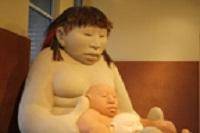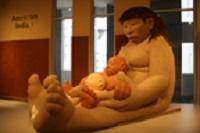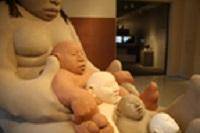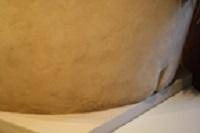Students will infer and interpret emotions represented in the gestural forms found in artist Roxanne Swentzell’s sculptures, particularly in the hands and feet. Students will choose an emotion to represent in a contour line drawing of hands or feet.
Students will be able to:
- compare and contrast the technical proficiency of artists to communicate ideas, emotions, and information;
- skillfully use the technique of contour drawing to visually express emotion; and
- demonstrate skills that utilize the characteristics and expressive features of art and design to communicate emotion and intended meaning.
Lesson
- Show students images of Mud Woman Rolls On and ask them to describe what they see. Ask if they can guess what materials were used to make the sculpture. Share with students pertinent background information from the About the Art section. Explain that this is a Pueblo Storyteller, which is an art form from the artist’s region and culture of the American Southwest, specifically the Santa Clara Pueblo in New Mexico. Point out that Mud Woman Rolls On has four children cradled in her lap. Notice the gentle hold the mother has on the children, how her arms and legs safely encompass them. Each of the children gently holds the younger child. They seem relaxed and at ease knowing they are safe and secure. Discuss with the class each of the figures in the sculpture and what they think each character feels. It is important to artist Roxanne Swentzell that the sculpture communicates a feeling of love. Share with students this quote from Roxanne (the full quote can be found in the About the Art section): “This piece is telling us a story; a story about generations and our connection to the Earth…to have human figures made of clay is in itself part of the theme. We are all from this Mother, all from this Earth: made of her and will return to her…We are the mothers of the next generation and the daughters of the last. Male or female…in the Pueblo world, we are ‘Mothers’ (nurturers) of the generations to come in a world that supports life. It is always good to remember…to nurture life, for it is our work now as it was for our parents and ancestors that came before us and it will become the work of our children. When we nurture life, we take care of the Earth and each other so life itself can continue.” How do the gestures of the figures communicate the themes Roxanne wanted to express? Pay attention to gestures and movement, especially in the hands and feet, which are larger in proportion to the rest of the figures’ bodies.
- When Roxanne was very young she had great difficulty communicating verbally so instead would sculpt small figures that would tell people what she wanted to say and how she felt. Look on the Creativity Resource website at another work of art by Roxanne Swentzell called The Things I Have to Do to Maintain Myself. Notice the positioning and gestures of the hands and feet in this work of art. How do those gestures communicate something different than Mud Woman Rolls On (To help facilitate discussion of this, you can share with students information about The Things I Have to Do to Maintain Myself, including that the figure is mending its own broken ear, and this information from the page on the sculpture: “With this sculpture, Swentzell references the idea that humans are in a constant state of development. An individual makes choices as he/she creates him/herself. Swentzell is also asking us to consider the importance of a seemingly mundane act. ‘I like to make the mundane significant, because that’s the way we go throughout days. This piece is about all the little things we do to make things possible. It’s an appreciation of something that’s now always acknowledged,’ says Swentzell.”)? Notice the sensitivity she gives to hands and feet and the way they express meaning and thoughts without the viewer reading or hearing a word. The gestures speak of untold emotions and thoughts.
- Ask students to choose an emotion to express in a contour line drawing, using only their hands or feet as a subject. Remind students to keep the expressions school appropriate and avoid vulgar gestures or gestures related to violent or illegal groups. Instead, focus on thoughts held in and emotions felt. For instance, a relaxed hand could show calm, a fist could show anger, a hand reaching out could share caring. Feet up on tip toes could show reaching; feet casually crossed could show nonchalance. Depending on the comfort level and atmosphere of your studio it might be more appropriate to keep shoes on if you are drawing feet. Shoes might also add an element of personality and variety to the line of the contour. You could photograph the hands and feet and draw from photos or choose a pose that the student can sustain and draw from life.
- Show examples of other contour line drawings and explain the procedure. It’s not an outline or a cartoon, but a line with various weights that follows all of the contours of the object.
- It might be helpful to first practice a blind contour drawing. Have students sit where they can see the hand they are drawing but cannot see their paper. Instruct students as follows: Pretend there is an imaginary dot on the hand you are drawing that is attached to your eyes and your pencil. Slowly imagine the dot moving around every crease and bend and contour of the subject hand. As the imaginary dot moves, draw its course on your hidden paper. Never look at your paper while you are drawing. If you lose your place, just try to put your pencil back where you think you might be. The object of this is to learn to really see what you are looking at, not to draw a perfect hand. If you are doing it right it will look mostly like a bunch of scribbles. You want to avoid the look of a cartoon glove; instead, you should be able to see where your eye followed each contour of the subject hand.
Day 2
- Once students understand the concept of a contour drawing, hand out good drawing paper and pencils. Have students create a contour drawing that expresses an emotion or feeling similar to the way the hands and feet in Roxanne Swentzell’s sculptures do.
- When drawings are finished, have an art critique or gallery walk and ask students to share what emotions they see in each other’s work. If you want a more structured activity, you can try some of these classroom-friendly art critiquing activities.
- Students might consider giving their work a title inspired by the emotion it expresses.
Optional: Students could bring in elements of reading, writing, and communicating by doing extemporaneous writing all around the hand that expresses in words the emotions and thoughts going on inside their minds.
Materials
- About the Art section on Mud Woman Rolls On (included with the lesson plan) or student access to this part of Creativity Resource online
- Student access to the object resource page for Swentzell’s The Things I Have to Do to Maintain Myself
- Color copies of Mud Woman Rolls On and The Things I Have to Do to Maintain Myself for students to share, or the ability to project the image onto a wall or screen
- Pencils and/or other media for drawing
- Paper for blind contour drawing
- Tape to hold down paper
- Good drawing paper
- If possible, various examples of contour drawings, particularly those of hands and feet (these can easily be found on Google Images if you search, for instance, “contour drawings of hands”)
- Optional: access to classroom-friendly art critiquing activities
Standards
- Visual Arts
- Invent and Discover to Create
- Observe and Learn to Comprehend
- Relate and Connect to Transfer
- Envision and Critique to Reflect
- Language Arts
- Oral Expression and Listening
- Writing and Composition
- Collaboration
- Critical Thinking & Reasoning
- Information Literacy
- Invention
- Self-Direction
Mud Woman Rolls On
- Roxanne Swentzell, Santa Clara, American, 1962-
- Born: Taos, NM
- Work Locations: New Mexico
Roxanne Swentzell was born in Taos, New Mexico in 1962. Her mother was a potter, writer, and scholar from Santa Clara Pueblo, and her father was a New Jersey native of German descent who was a philosophy professor in Santa Fe. Growing up in Santa Fe, in a household that was filled with clay and artwork, Roxanne took to art-making at an early age. As a child, she struggled to express herself verbally. In order to let others know how she was feeling, she would sculpt small figures that represented her emotions.
Roxanne attributes much of her success to guidance from her family, particularly her mother, Rina, and her uncle, Michael Naranjo, a blind sculptor. From 1978-1980, before graduating high school, she attended the Institute of American Indian Arts.
Today, she spends much of her time at Tower Studio, twelve miles north of Santa Fe. Continuing her interests in nature and preserving the earth, Swentzell founded the Flowering Tree Permaculture Institute, “a research and education organization that relates to permaculture…a way of looking at the world based on the laws of nature.”
Swentzell believes that it is extremely important for her work to have a direct connection with reality. Her art must be a full expression of herself and her experiences and observations of life. She says, “I learned to listen to myself and not be so influenced by what other people wanted me to make. I am going to present the world through my eyes—and not as somebody told me I was supposed to.” She also aims to communicate with all people through her artwork—both Native and non-Native—about the things we share as humans. “With my sculptures I try to reach people’s emotions so they can remember themselves,” says Swentzell.
Artist’s Statement on Mud Woman Rolls On, written by Roxanne Swentzell:
I propose creating a piece that is made from different forms of “mud.” A large female figure holds a few smaller figures (her children). This style of figure is known as a Storyteller. Pueblo Storytellers are about how knowledge is passed down through generations.
This piece is telling us a story; a story about generations and our connection to the Earth.
When asked to create a piece for the entrance of the Native American Exhibit section of the Denver Art Museum, I wanted to start the viewer off with a perspective of Earth and Mother. Having a “Mother” made of mud/clay starts the exhibit off in an appropriate beginning to our Native world. To have human figures made of clay is in itself part of the theme. We are all from this Mother, all from this Earth: made of her and will return to her.
The Storyteller will be in the form of generations. The Mother holds the largest child, who’s holding the next child, who’s holding the next and so on. I love the perspective of understanding that we all come from the Earth, generation after generation; an endless family of life passing on the seed. (Which itself is a story written into our genes.) We are the mothers of the next generation and the daughters of the last. Male or female........in the Pueblo world, we are “Mothers” (nurturers) of the generations to come in a world that supports life. It is always good to remember…to nurture life, for it is our work now as it was for our parents and ancestors that came before us and it will become the work of our children. When we nurture life, we take care of the Earth and each other so life itself can continue.
I will mix the medium of the piece with raw unfired mud plastered over a basket-like structure with parts of the features sculpted with fired earthenware clay. Some of the mud will have straw in it, and other parts, different clay pigments to create color. I find these different forms very interesting to create as an artist and also I love the thought of creating a piece that could actually melt down into mud if dumped into water. Just as all of us will return to the Earth, so will this Mud Woman one day…purposefully. To create a fine arts piece for a Museum out of raw mud creates a new consciousness in the world of art and links two very different cultures, the Western World with the Native American world. I am very excited to help to make this bridge.
As the “Mother” figure is very large, the children will be more human size. This helps the viewer relate to the Mother as their Mother and the children as themselves. From this perspective the viewer sees their place in creation clearer. They view themselves in the context of generations from the beginning of time into the future, all connected. To hurt one part of the chain of life is to disrupt the flow that nurtures the generations to come. I believe this story is certainly one that needs telling at this time.
Details

Site-specific
Mud Woman Rolls On is a site-specific work of art. The DAM commissioned Roxanne Swentzell to create this piece as part of the opening installation of the new American Indian art galleries on the 3rd floor of the North Building. Roxanne started working on the piece January of 2011 and continued to work for the next nine months, traveling to Denver from New Mexico to work for three or four days straight once or twice a month. Swentzell completed the piece in September 2011.

Backdrop
Panels plastered with clay and enhanced with straw form the backdrop for this piece. The backdrop was created by Roxanne’s sister, Athena Steen, and her husband, Bill Steen. The Steens are authorities on straw bale houses and have created crossover art/architecture pieces for museums, as well as private clients.

Size and Location
Mud Woman is nearly 11 feet tall and located in the elevator lobby of the DAM’s American Indian art gallery. This is a permanent piece in the museum’s collection and the first object a visitor sees when they walk out of the elevator. It was important to Roxanne that this sculpture communicate a feeling of love to the visitors walking into the gallery and that people would be able to relate to the size of the sculpted children, who are being embraced by Mud Woman.

Straw Wattles
Mud Woman Rolls On was Swentzell’s first attempt at creating something larger than life-size. In order to build a structure so large, which would last a long time and support a lot of weight, Swentzell used straw wattles (long tubes of straw used most commonly for erosion control) for the base of the sculpture. Using a straw base is a standard practice for adobe construction and using flexible wattles (instead of rigid, square-shaped straw bales) allowed Swentzell to “coil” the tubes in a way very similar to how she would coil clay. If you look closely, you can see where some straw is still exposed.

Children and Motherhood
Mud Woman is holding four children and, in turn, each of the children are holding one another. This idea of the mother (nurturer) with children around her is based on the Pueblo Storyteller tradition and was an important inspiration for Swentzell. As she explains in her artist’s statement, “Pueblo Storytellers are about how knowledge is passed down through generations.” It is also interesting to note that this project took nine months to complete, the same amount of time it takes for a child to be born.

Different Colors and Types of Mud
The mud (a combination of dirt, sand, straw, and water) used to make this piece comes in a variety of colors. Roxanne Swentzell carefully selected the type of mud to use for each of the figures based on their look and their location. For example, the second smallest child is a grayish green and the dirt used to make the mud that covers this figure came directly from an area behind the train station in downtown Denver. Other mud ingredients were either purchased or dug up from areas surrounding Santa Fe, New Mexico. When looking at the sculpture up close, one can see the subtle sparkle of micaceous clay that covers the surface of the mother figure. All of these examples were meaningful choices made by the artist.

Grass Hair
Swentzell used a variety of different grasses, dyed different colors, for Mud Woman’s hair. This feature emphasizes that Mud Woman is made entirely of organic, natural materials. In this detail, you can see how the ends of the “hair strands” are shafts of grass.

Humor
Roxanne Swentzell often infuses her sense of humor into her work. This particular detail shows where Roxanne chose to write her signature. When visitors walk around the piece and find this detail, most think it is delightfully “cheeky.”
Funding for object education resources provided by a grant from the Morgridge Family Foundation. Additional funding provided by the William Randolph Hearst Endowment for Education Programs, and Xcel Energy Foundation. We thank our colleagues at the University of Denver Morgridge College of Education.
The images on this page are intended for classroom use only and may not be reproduced for other reasons without the permission of the Denver Art Museum. This object may not currently be on display at the museum.







